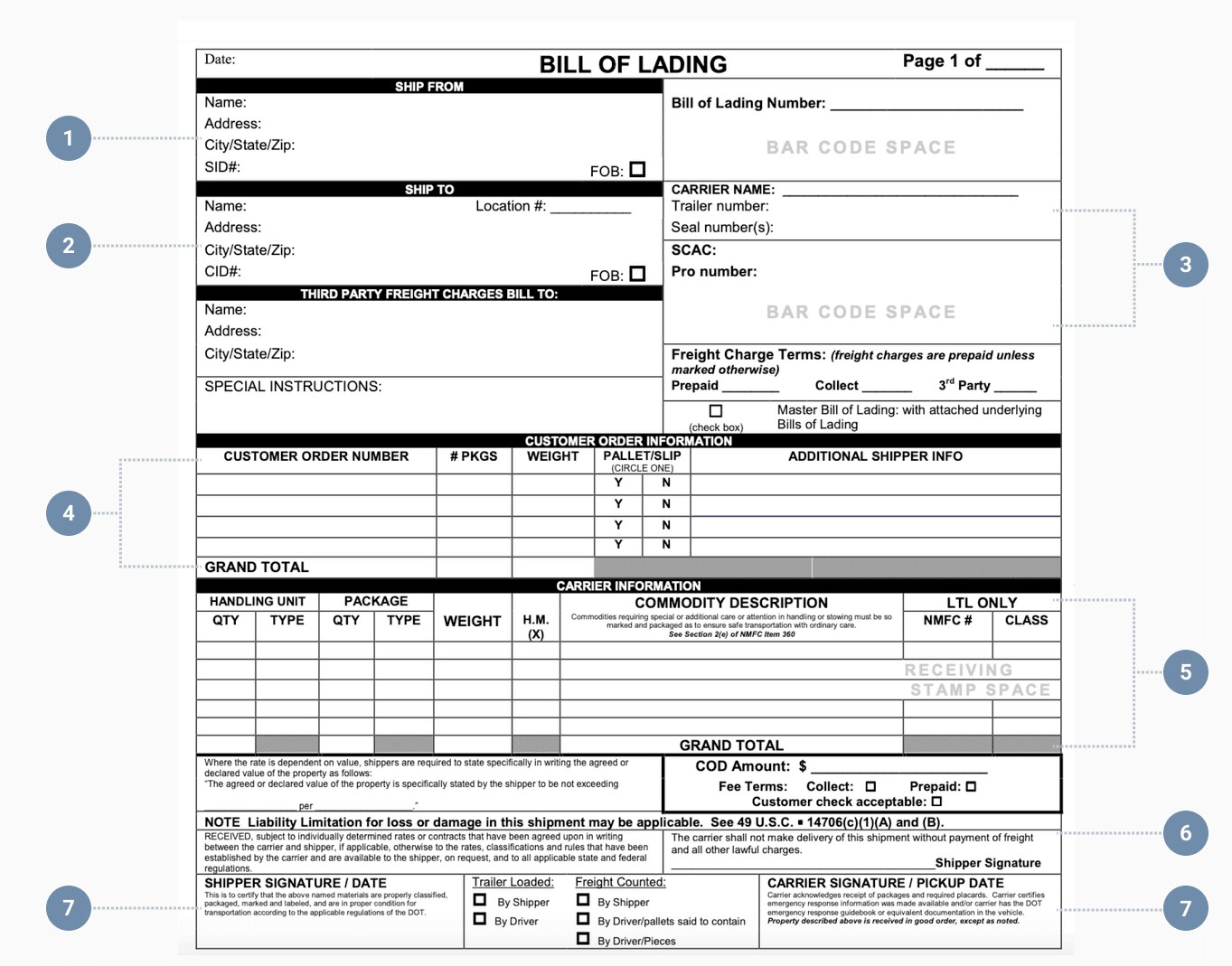What Is a Bill of Lading (BOL)?
A bill of lading is a freight shipping document that summarizes all the information for a particular shipment:It’s called a ‘bill of lading’ because lading is the Old English word for ‘loading’ in the 16th century, which is when it was first issued.
What Is the Function of a Bill of Lading?
In the shipping and logistics industry, a bill of lading has three functions:
- It acts as a receipt for goods shipped for shippers. Once a carrier issues a BOL to a shipper, they acknowledge
thatthey have received the shipment and that they plan to transport it to the destination indicated on the BOL. - It acts as a contract for carriage between carriers and shippers. The BOL acts as an agreement between these two parties for the transportation of the shipper’s goods by the carrier.
- It acts as a document of title to the goods for consignees. The BOL functions as a proof of claim to a shipment by the consignee. Since carriers handle thousands of different shipments at any given point of time and at different points of a supply chain, this function protects them from handing over the wrong shipment to the wrong party.
Types of Bills of Lading
For a straightforward document, there are a surprising number of bill of lading types.
Each of these bill of lading types contain subtle differences applied to a standard bill of lading. The differences depend on the transferability of the BOL (negotiable vs. non-negotiable), the payment status of the goods in a shipment, conditionof the goods, and the mode of transport used.
A bill of lading can overlap categories. For example, if a carrier ships goods by air to a specific consignee who has already paid for their goods, the bill of lading would be a non-negotiable straight master air waybill.
Negotiable vs. non-negotiable bill of lading
A negotiable bill of lading can be transferred to a third party who can claim title to the possession of the shipped goods.
A non-negotiable bill of lading is non-transferrable i.e. the consignee listed on a non-negotiable bill of lading is the only party who can claim title to the possession of the shipped goods.
For example, if your small business frequently orders products from a manufacturer in China, you might use a shipping agent who works with your manufacturer to ensure your products arrive on time. In this case, having a negotiable bill of lading enables your shipping agent to pick up your products from their port of arrival and send them directly to your business’s location.
Straight vs. to order bill of lading
The difference between a straight bill of lading and a to order bill of lading is the payment status of the goods being shipped.
A straight bill of lading is issued when the goods have been paid for in advance by the consignee to the shipper. A straight bill of lading also falls under the non-negotiable bill of lading category.
A to order bill of lading is issued when the goods have been purchased on credit and the shipment is being handled through a bank. A to order bill of lading is a negotiable bill of lading.
Clean vs. claused bill of lading
The difference between a clean and a claused bill of lading is the condition of the goods shipped. A clean bill of lading covers goods that are received in an acceptable condition. A claused bill of lading covers goods that are received in a damaged condition.
Mode of transport types
Depending on how your goods are shipped, you’ll have to use different types of bills of lading. There may also be special considerations for certain types of shipments, such as international shipments or large shipments.
- Ocean Bill of Lading – goods shipped over sea where shippers want to retain control over title of goods.
- Sea Waybill – non-negotiable variant of the ocean bill of lading.
- Master Air Waybill – freight shipments shipped by air.
- Inland Bill of Lading – freight shipments shipped over land (rail or road).
- Multimodal Bill of Lading – goods are shipped over more than one mode of transport. Sea + road, sea + rail etc.
- House Bill of Lading – goods are shipped through a freight forwarder for Less than Container Load (LCL) or less than truckload (LTL) shipments.
Bill of Lading Template
Every bill of lading contains similar categories of information you need in order to prepare for your shipments. Here is a sample non-negotiable bill of lading:

A bill of lading can be broken down into the following sections:
- Shipper Information: shipper’s name, address, and email & phone number.
- Consignee Information: consignee’s name, address, and email & phone number.
- Shipment Tracking Information: trailer number, seal number, standard carrier alpha code (SCAC), and pro numbers are all used to track shipments in the freight industry.
- Customer Order Information: all the information related to the shipper’s items that are being handled by the carrier, including order number, number of packages, weight, and whether a pallet is included in the shipment.
- Carrier Information: all the information related to the shipment relevant to the carrier, including quantity and type of handling units and packages, weight, and a general description of the product.
- COD Amount: the amount payable to the carrier for transporting the shipment, either by the consignee (Collect) or by the shipper (Prepaid).
- Signatures: Both the shipper and the carrier sign the BOL since it’s a contract of carriage.
